
Earth's outer core is a fluid layer about 2,260 km (1,400 mi) thick, composed of mostly iron and nickel that lies above Earth's solid inner core and below its mantle. The outer core begins approximately 2,889 km (1,795 mi) beneath Earth's surface at the core-mantle boundary and ends 5,150 km (3,200 mi) beneath Earth's surface at the inner core boundary.

Earth's magnetic field, also known as the geomagnetic field, is the magnetic field that extends from Earth's interior out into space, where it interacts with the solar wind, a stream of charged particles emanating from the Sun. The magnetic field is generated by electric currents due to the motion of convection currents of a mixture of molten iron and nickel in Earth's outer core: these convection currents are caused by heat escaping from the core, a natural process called a geodynamo.

Paleomagnetism is the study of prehistoric Earth's magnetic fields recorded in rocks, sediment, or archeological materials. Geophysicists who specialize in paleomagnetism are called paleomagnetists.
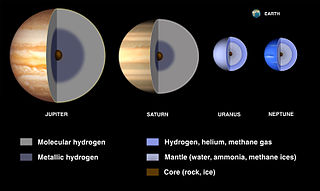
A planetary core consists of the innermost layers of a planet. Cores may be entirely solid or entirely liquid, or a mixture of solid and liquid layers as is the case in the Earth. In the Solar System, core sizes range from about 20% to 85% of a planet's radius (Mercury).
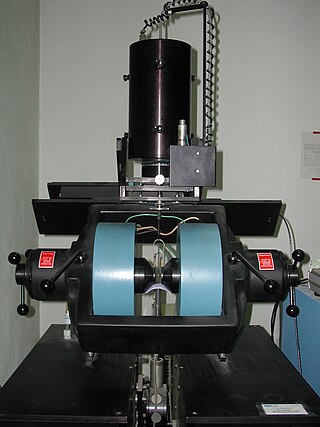
Rock magnetism is the study of the magnetic properties of rocks, sediments and soils. The field arose out of the need in paleomagnetism to understand how rocks record the Earth's magnetic field. This remanence is carried by minerals, particularly certain strongly magnetic minerals like magnetite. An understanding of remanence helps paleomagnetists to develop methods for measuring the ancient magnetic field and correct for effects like sediment compaction and metamorphism. Rock magnetic methods are used to get a more detailed picture of the source of the distinctive striped pattern in marine magnetic anomalies that provides important information on plate tectonics. They are also used to interpret terrestrial magnetic anomalies in magnetic surveys as well as the strong crustal magnetism on Mars.

Earth's inner core is the innermost geologic layer of the planet Earth. It is primarily a solid ball with a radius of about 1,220 km (760 mi), which is about 20% of Earth radius or 70% of the Moon's radius.

Terra Sirenum is a large region in the southern hemisphere of the planet Mars. It is centered at 39.7°S 150°W and covers 3900 km at its broadest extent. It covers latitudes 10 to 70 South and longitudes 110 to 180 W. Terra Sirenum is an upland area notable for massive cratering including the large Newton Crater. Terra Sirenum is in the Phaethontis quadrangle and the Memnonia quadrangle of Mars. A low area in Terra Sirenum is believed to have once held a lake that eventually drained through Ma'adim Vallis.

Magnetofossils are the fossil remains of magnetic particles produced by magnetotactic bacteria (magnetobacteria) and preserved in the geologic record. The oldest definitive magnetofossils formed of the mineral magnetite come from the Cretaceous chalk beds of southern England, while magnetofossil reports, not considered to be robust, extend on Earth to the 1.9-billion-year-old Gunflint Chert; they may include the four-billion-year-old Martian meteorite ALH84001.
Natural remanent magnetization is the permanent magnetism of a rock or sediment. This preserves a record of the Earth's magnetic field at the time the mineral was laid down as sediment or crystallized in magma and also the tectonic movement of the rock over millions of years from its original position. Natural remanent magnetization forms the basis of paleomagnetism and magnetostratigraphy.

The Vine–Matthews–Morley hypothesis, also known as the Morley–Vine–Matthews hypothesis, was the first key scientific test of the seafloor spreading theory of continental drift and plate tectonics. Its key impact was that it allowed the rates of plate motions at mid-ocean ridges to be computed. It states that the Earth's oceanic crust acts as a recorder of reversals in the geomagnetic field direction as seafloor spreading takes place.
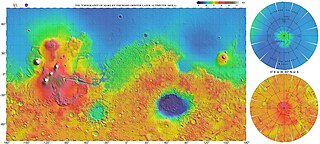
The most conspicuous feature of Mars is a sharp contrast, known as the Martian dichotomy, between the Southern and the Northern hemispheres. The two hemispheres' geography differ in elevation by 1 to 3 km. The average thickness of the Martian crust is 45 km, with 32 km in the northern lowlands region, and 58 km in the southern highlands.
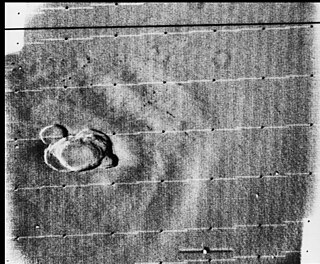
Volcanic activity, or volcanism, has played a significant role in the geologic evolution of Mars. Scientists have known since the Mariner 9 mission in 1972 that volcanic features cover large portions of the Martian surface. These features include extensive lava flows, vast lava plains, and the largest known volcanoes in the Solar System. Martian volcanic features range in age from Noachian to late Amazonian, indicating that the planet has been volcanically active throughout its history, and some speculate it probably still is so today. Both Earth and Mars are large, differentiated planets built from similar chondritic materials. Many of the same magmatic processes that occur on Earth also occurred on Mars, and both planets are similar enough compositionally that the same names can be applied to their igneous rocks and minerals.
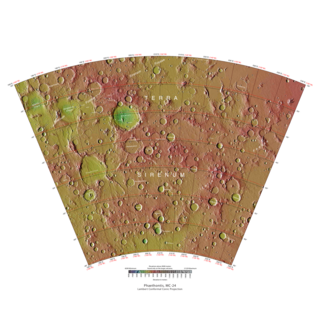
The Phaethontis quadrangle is one of a series of 30 quadrangle maps of Mars used by the United States Geological Survey (USGS) Astrogeology Research Program. The Phaethontis quadrangle is also referred to as MC-24.
Plate reconstruction is the process of reconstructing the positions of tectonic plates relative to each other or to other reference frames, such as the Earth's magnetic field or groups of hotspots, in the geological past. This helps determine the shape and make-up of ancient supercontinents and provides a basis for paleogeographic reconstructions.

The composition of Mars covers the branch of the geology of Mars that describes the make-up of the planet Mars.
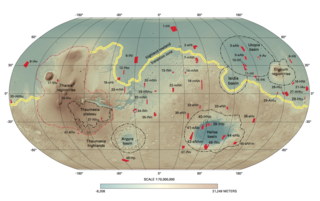
Like the Earth, the crustal properties and structure of the surface of Mars are thought to have evolved through time; in other words, as on Earth, tectonic processes have shaped the planet. However, both the ways this change has happened and the properties of the planet's lithosphere are very different when compared to the Earth. Today, Mars is believed to be largely tectonically inactive. However, observational evidence and its interpretation suggests that this was not the case further back in Mars' geological history.

Crustal magnetism is the magnetic field of the crust of a planetary body. The crustal magnetism of Earth has been studied; in particular, various magnetic crustal anomalies have been studied. Two examples of crustal magnetic anomalies on Earth that have been studied in the Americas are the Brunswick magnetic anomaly (BMA) and East Coast magnetic anomaly (ECMA). Also, there can be a correlation between physical geological features and certain readings from crustal magnetism on Earth. Below the surface of the Earth, the crustal magnetism is lost because the temperature rises above the curie temperature of the materials producing the field.

The gravity of Mars is a natural phenomenon, due to the law of gravity, or gravitation, by which all things with mass around the planet Mars are brought towards it. It is weaker than Earth's gravity due to the planet's smaller mass. The average gravitational acceleration on Mars is 3.72076 m/s2 and it varies.
Subir Kumar Banerjee is an Indian-American geophysicist, known for research on rock magnetism, palaeomagnetism, and environmental magnetism.

Mars' carbonate catastrophe was an event that happened on Mars in its early history. Evidence shows Mars was once warmer and wet about 4 billion years ago, that is about 560 million years after the formation of Mars. Mars quickly, over a 1 to 12 million year time span, lost its water, becoming cold and very dry. Factors in Mars losing its water and most of its atmosphere are: the carbonate catastrophe, loss of the planet's magnetic field and Mars' low gravity. Mars' low gravity and loss of a magnetic field allowed the Sun's solar wind to strip away most of Mars' atmosphere and water into outer space.


![Timeline of the Martian dynamo. Grey shading represents possible age constraints (in Ga years) for the early and late dynamo. Stars indicate new age constraints from MAVEN data. [a] Early dynamo before the formation of Hellas, Isidis, and Argyre. [b] The cessation of the early dynamo based on large basin population. [c] The age of ALH84001. [d] Late dynamo after the formation of the major basins. Timing of the Martian Dynamo.jpg](http://upload.wikimedia.org/wikipedia/commons/thumb/4/4c/Timing_of_the_Martian_Dynamo.jpg/811px-Timing_of_the_Martian_Dynamo.jpg)
















